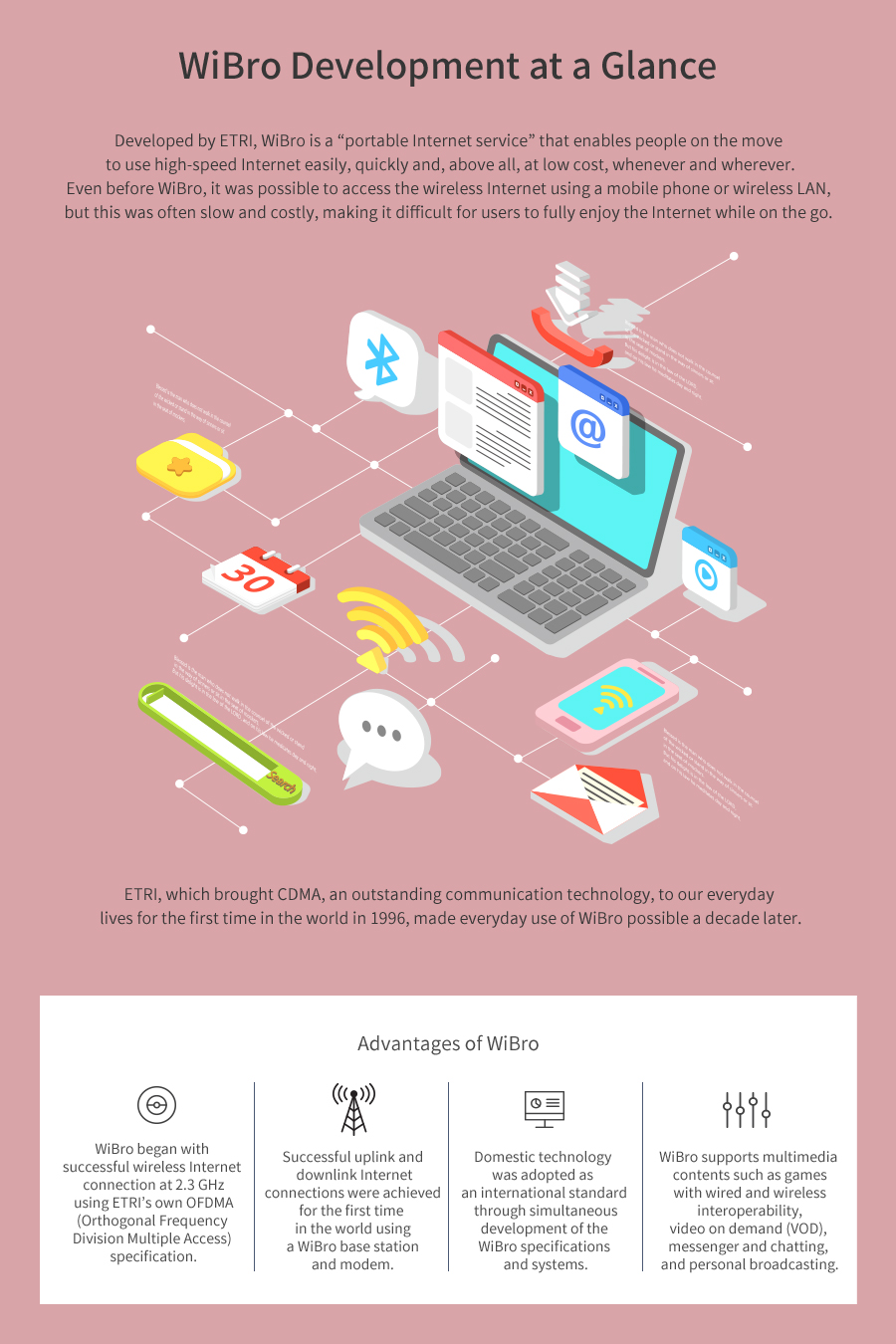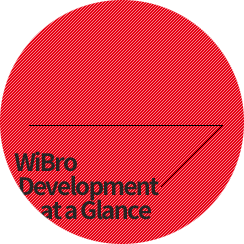
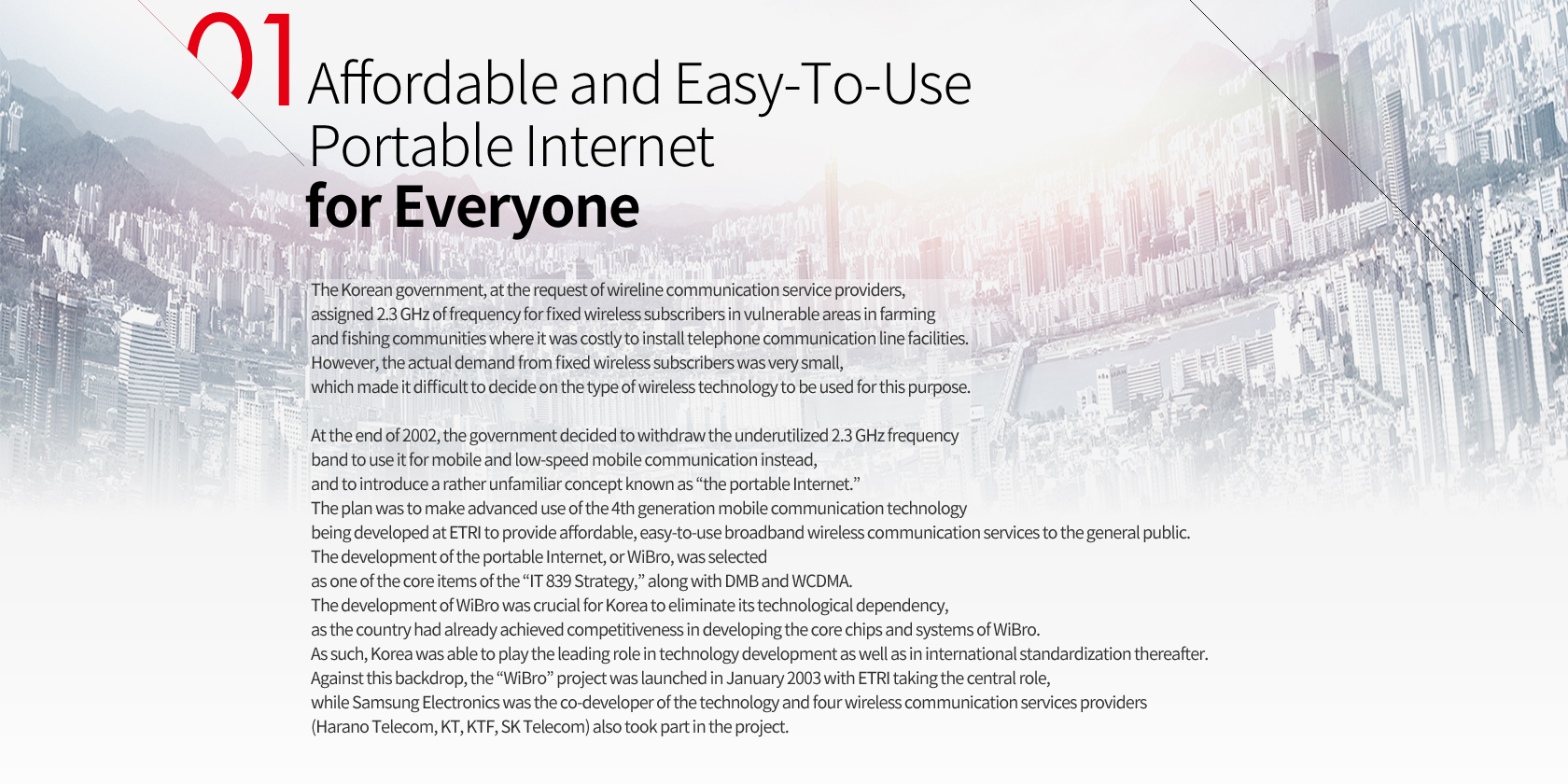
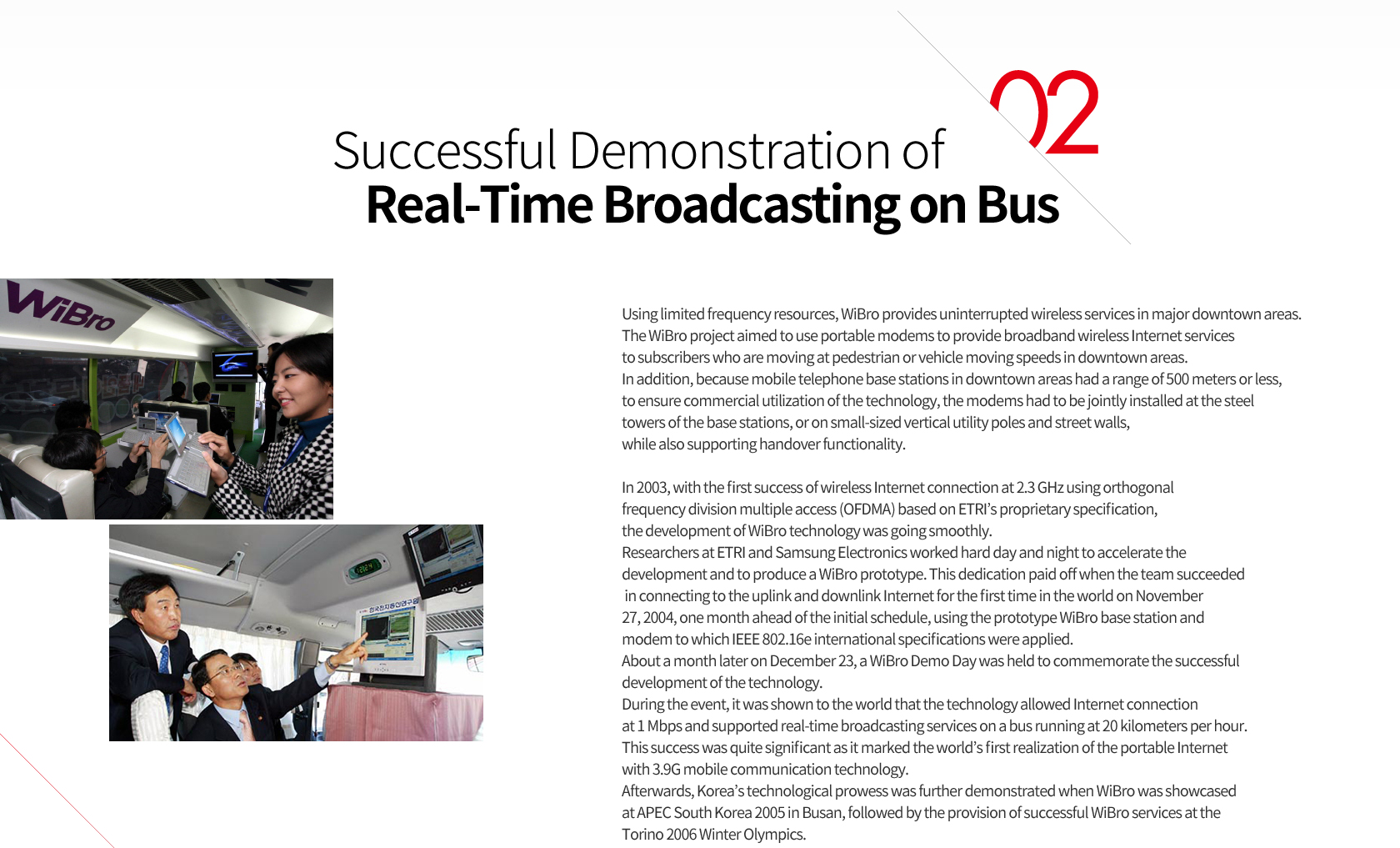
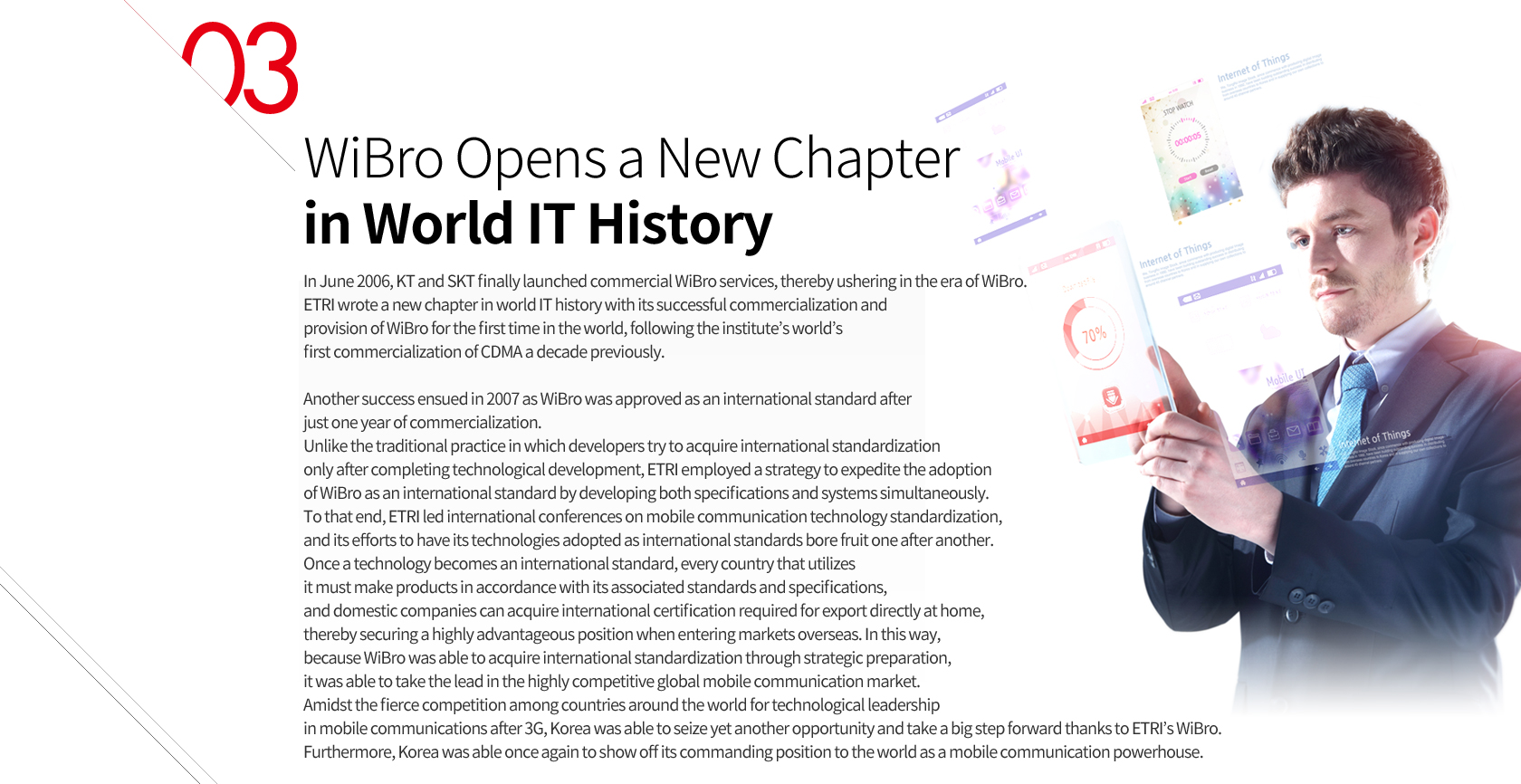
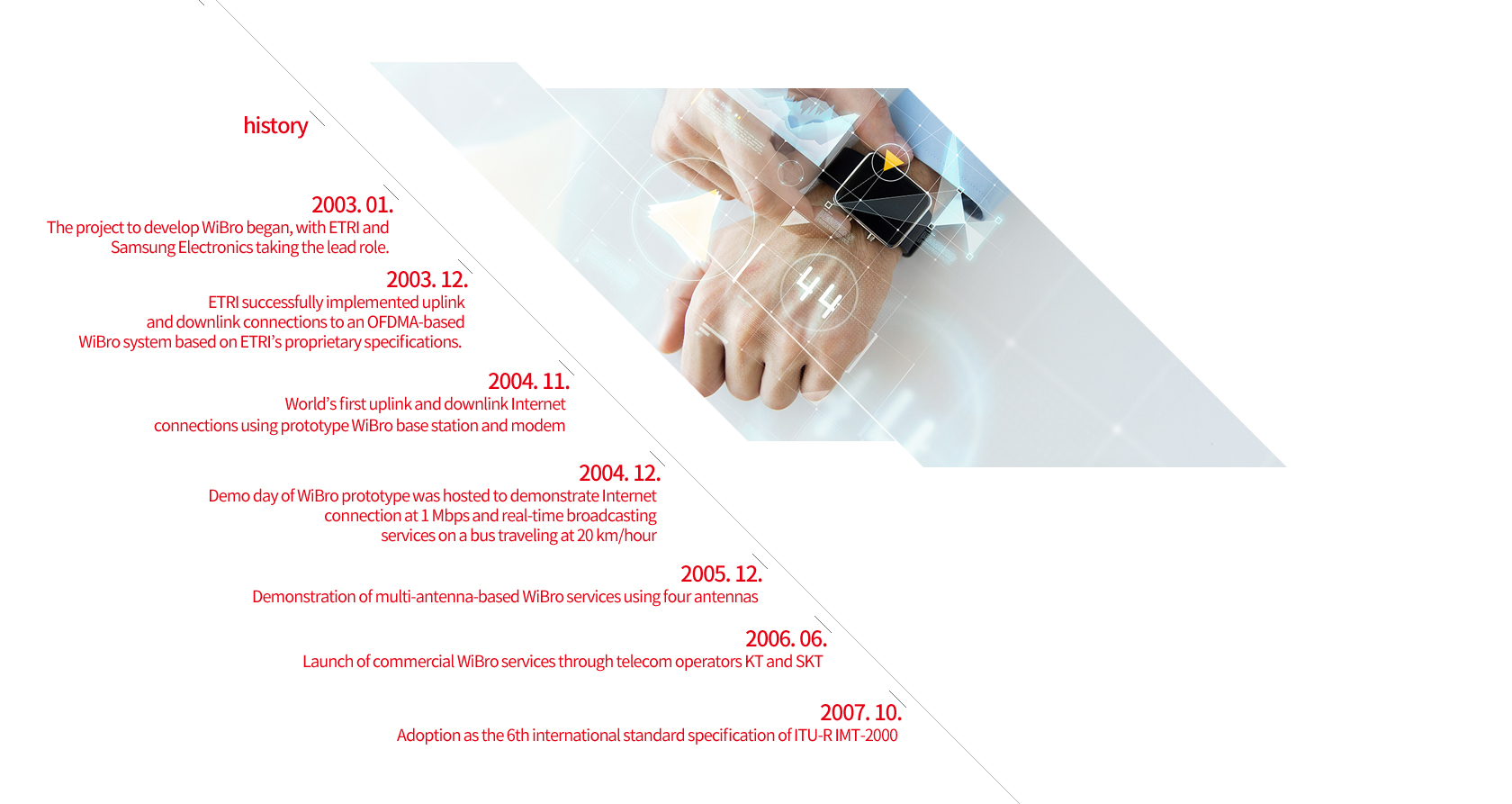
ETRI’s
Technologies
Become
International
Standards
Wireless Broadband Internet (WiBro), which enables access to the Internet anytime and anywhere, is situated in the middle of existing 3G/4G mobile communication technologies for mobile phones and Wi-Fi, in terms of radius of coverage.
The technology drew attention as a 3.9 generation mobile communication system that enabled high-performance, high-speed Internet connection that was available indoors as well asoutdoors even in both stationary and mobile environments by using a portable modem at low cost.
WiBro was an innovative technology that not only overcame the limitations of the costly yet slow wireless Internet for mobile phones but also addressed the shortcomings of wireless LAN, which restricted mobility and positioning.
01
Affordable and Easy-To-Use
Portable Internet
for Everyone
The Korean government, at the request of wireline communication service providers, assigned 2.3 GHz of frequency for fixed wireless subscribers in vulnerable areas in farming and fishing communities where it was costly to install telephone communication line facilities. However, the actual demand from fixed wireless subscribers was very small, which made it difficult to decide on the type of wireless technology to be used for this purpose.
At the end of 2002, the government decided to withdraw the underutilized 2.3 GHz frequency band to use it for mobile and low-speed mobile communication instead, and to introduce a rather unfamiliar concept known as “the portable Internet.” The plan was to make advanced use of the 4th generation mobile communication technology being developed at ETRI to provide affordable, easy-to-use broadband wireless communication services to the general public. The development of the portable Internet, or WiBro, was selected as one of the core items of the “IT 839 Strategy,” along with DMB and WCDMA. The development of WiBro was crucial for Korea to eliminate its technological dependency, as the country had already achieved competitiveness in developing the core chips and systems of WiBro. As such, Korea was able to play the leading role in technology development as well as in international standardization thereafter. Against this backdrop, the “WiBro” project was launched in January 2003 with ETRI taking the central role, while Samsung Electronics was the co-developer of the technology and four wireless communication services providers (Harano Telecom, KT, KTF, SK Telecom) also took part in the project.

02
Successful Demonstration of
Real-Time Broadcasting
on Bus
Using limited frequency resources, WiBro provides uninterrupted wireless services in major downtown areas. The WiBro project aimed to use portable modems to provide broadband wireless Internet services to subscribers who are moving at pedestrian or vehicle moving speeds in downtown areas. In addition, because mobile telephone base stations in downtown areas had a range of 500 meters or less, to ensure commercial utilization of the technology, the modems had to be jointly installed at the steel towers of the base stations, or on small-sized vertical utility poles and street walls, while also supporting handover functionality.
In 2003, with the first success of wireless Internet connection at 2.3 GHz using orthogonal frequency division multiple access (OFDMA) based on ETRI’s proprietary specification, the development of WiBro technology was going smoothly. Researchers at ETRI and Samsung Electronics worked hard day and night to accelerate the development and to produce a WiBro prototype. This dedication paid off when the team succeeded in connecting to the uplink and downlink Internet for the first time in the world on November 27, 2004, one month ahead of the initial schedule, using the prototype WiBro base station and modem to which IEEE 802.16e international specifications were applied. About a month later on December 23, a WiBro Demo Day was held to commemorate the successful development of the technology. During the event, it was shown to the world that the technology allowed Internet connection at 1 Mbps and supported real-time broadcasting services on a bus running at 20 kilometers per hour. This success was quite significant as it marked the world’s first realization of the portable Internet with 3.9G mobile communication technology. Afterwards, Korea’s technological prowess was further demonstrated when WiBro was showcased at APEC South Korea 2005 in Busan, followed by the provision of successful WiBro services at the Torino 2006 Winter Olympics.

03
WiBro Opens a New Chapter
in World IT History
In June 2006, KT and SKT finally launched commercial WiBro services, thereby ushering in the era of WiBro. ETRI wrote a new chapter in world IT history with its successful commercialization and provision of WiBro for the first time in the world, following the institute’s world’s first commercialization of CDMA a decade previously.
Another success ensued in 2007 as WiBro was approved as an international standard after just one year of commercialization. Unlike the traditional practice in which developers try to acquire international standardization only after completing technological development, ETRI employed a strategy to expedite the adoption of WiBro as an international standard by developing both specifications and systems simultaneously. To that end, ETRI led international conferences on mobile communication technology standardization, and its efforts to have its technologies adopted as international standards bore fruit one after another. Once a technology becomes an international standard, every country that utilizes it must make products in accordance with its associated standards and specifications, and domestic companies can acquire international certification required for export directly at home, thereby securing a highly advantageous position when entering markets overseas. In this way, because WiBro was able to acquire international standardization through strategic preparation, it was able to take the lead in the highly competitive global mobile communication market. Amidst the fierce competition among countries around the world for technological leadership in mobile communications after 3G, Korea was able to seize yet another opportunity and take a big step forward thanks to ETRI’s WiBro. Furthermore, Korea was able once again to show off its commanding position to the world as a mobile communication powerhouse.
- 2003. 01.
- The project to develop WiBro began, with ETRI and Samsung Electronics taking the lead role.
- 2003. 12.
- ETRI successfully implemented uplink and downlink connections to an OFDMA-based WiBro system based on ETRI’s proprietary specifications.
- 2004. 11.
- World’s first uplink and downlink Internet connections using prototype WiBro base station and modem
- 2004. 12.
- Demo day of WiBro prototype was hosted to demonstrate Internet connection at 1 Mbps and real-time broadcasting services on a bus traveling at 20 km/hour
- 2005. 12.
- : Demonstration of multi-antenna-based WiBro services using four antennas
- 2006. 06.
- Launch of commercial WiBro services through telecom operators KT and SKT
- 2007. 10.
- : Adoption as the 6th international standard specification of ITU-R IMT-2000
